Configuring PTRS
This notebook shows different PTRS configurations
[1]:
import numpy as np
import scipy.io
from neoradium import Carrier, PDSCH, Grid
[2]:
carrier = Carrier(numRbs=5, spacing=30) # 5*12*30000 = 1,800,000 Hz
carrier.print()
Carrier Properties:
Cell Id: 1
Bandwidth Parts: 1
Active BWP: 0
Bandwidth Part 0:
Resource Blocks: 5 RBs starting at 0 (60 subcarriers)
Subcarrier Spacing: 30 kHz
CP Type: normal
Bandwidth: 1.8 MHz
symbolsPerSlot: 14
slotsPerSubFrame: 2
nFFT: 1024
frameNo: 0
slotNo: 0
[3]:
# Create a 2-layer PDSCH with Mapping Type A (default) using All Symbols and PRBs in the BWP (default)
pdsch = PDSCH(carrier.curBwp, numLayers=2)
pdsch.setDMRS() # Default DMRS settings
pdsch.setPTRS() # Default PTRS settings
pdsch.print()
PDSCH Properties:
mappingType: A
nID: 1
rnti: 1
numLayers: 2
numCodewords: 1
modulation: 16QAM
portSet: [0, 1]
symSet: 0 1 2 3 4 5 6 7 8 9 10 11 12 13
prbSet: 0 1 2 3 4
interleavingBundleSize: 0
PRG Size: Wideband
Bandwidth Part:
Resource Blocks: 5 RBs starting at 0 (60 subcarriers)
Subcarrier Spacing: 30 kHz
CP Type: normal
Bandwidth: 1.8 MHz
symbolsPerSlot: 14
slotsPerSubFrame: 2
nFFT: 1024
frameNo: 0
slotNo: 0
DMRS:
configType: 1
nIDs: []
scID: 0
sameSeq: 1
symbols: Single
typeA1stPos: 2
additionalPos: 0
cdmGroups: [0, 0]
deltaShifts: [0, 0]
allCdmGroups: [0]
symSet: [2]
REs (before shift): [0, 2, 4, 6, 8, 10]
epreRatioDb: 0 (dB)
PTRS:
timeDensity: 1
freqDensity: 2
reOffset: 0
portSet: [0]
epreRatio: 0
symSet: [0, 1, 3, 4, 5, 6, 7, 8, 9, 10, 11, 12, 13]
[4]:
# Get a resource grid from the PDSCH object. This creates a Grid object and populates it with the DMRS values
grid = pdsch.getGrid()
grid.getStats() # Print some statistics about the grid
[4]:
{'GridSize': 1680, 'DMRS': 60, 'PTRS': 39, 'PDSCH': 1581}
[5]:
# Draw grid map for all layers, one slot and one PRB (reRange=(0,12))
grid.drawMap(pdsch.portSet, reRange=(0,12))
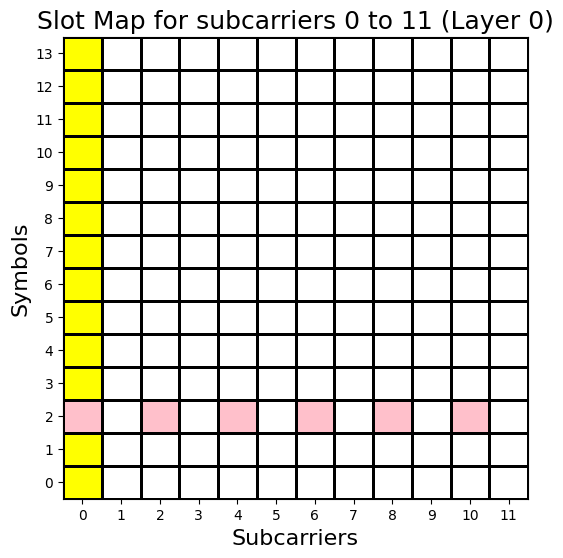
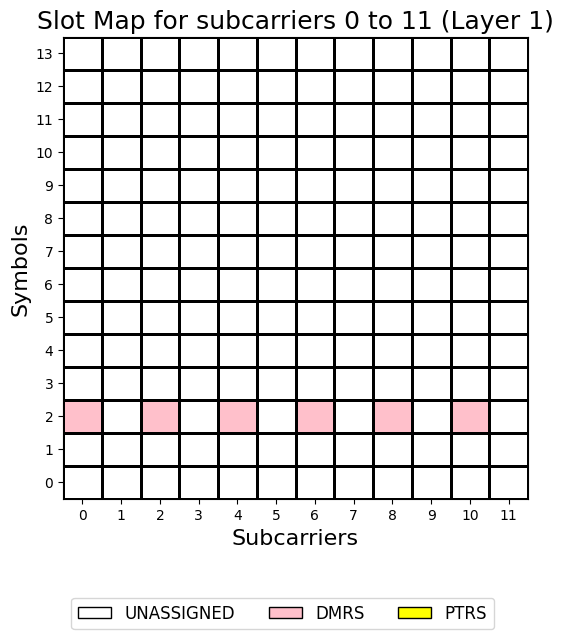
[6]:
# Let's see an example of DMRS with double symbol (symbols=2) with PTRS timeDensity of 2 which
# means PTRS values at every other OFDM symbol. (Drawing only for one layer)
pdsch.setDMRS(symbols=2)
pdsch.setPTRS(timeDensity=2)
pdsch.getGrid().drawMap()
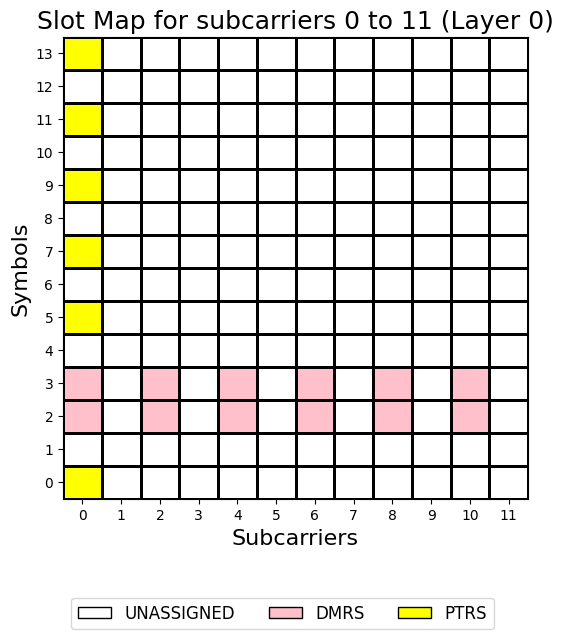
[7]:
# Using 2 additional symbol positions for DMRS (additionalPos=2) with PTRS reOffset=3 (or '11') which
# means having PTRS at RE index 8 (See "resourceElementOffset" in 3GPP TS 38.211, Table 6.4.1.2.2.1-1).
pdsch.setDMRS(additionalPos=2)
pdsch.setPTRS(timeDensity=2, reOffset=3)
pdsch.getGrid().drawMap(title="DMRS with 2 more symbol allocations (additionalPos=2)")
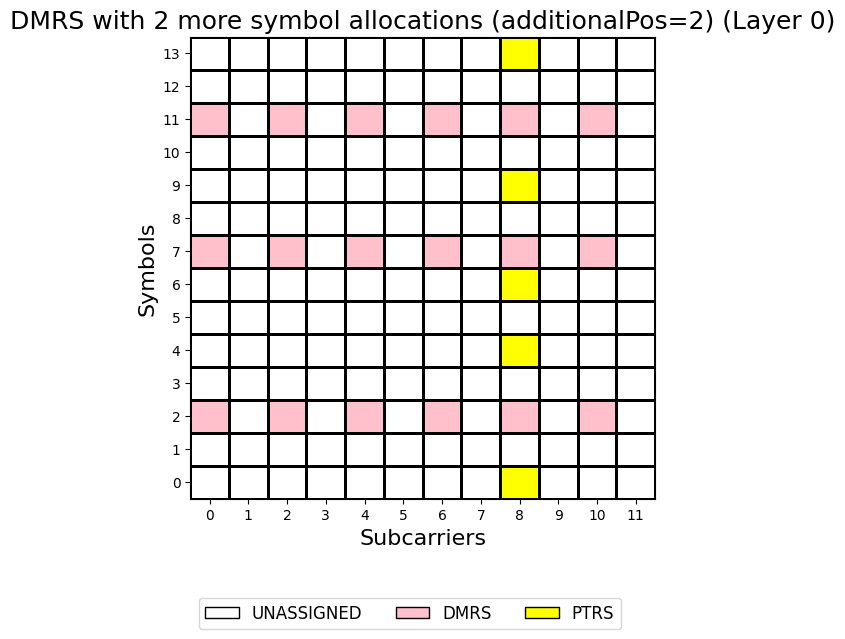
[8]:
# Comparing freqDensity=2 vs freqDensity=4
# Using 1 additional symbol positions for DMRS (additionalPos=1) with PTRS reOffset=1 (or '01') which
# means having PTRS at RE index 2 (See "resourceElementOffset" in 3GPP TS 38.211, Table 6.4.1.2.2.1-1).
# We do this once with freqDensity=2 (default) and once with freqDensity=4 and compare the map for
# 5 RBs (60 REs)
pdsch.setDMRS(additionalPos=1)
pdsch.setPTRS(timeDensity=2, freqDensity=2, reOffset=1) # PTRS in every other RB
pdsch.getGrid().drawMap(reRange=(0,60), title="PTRS with freqDensity=2")
pdsch.setPTRS(timeDensity=2, freqDensity=4, reOffset=1) # PTRS in every other 4 RBs
pdsch.getGrid().drawMap(reRange=(0,60), title="PTRS with freqDensity=4")
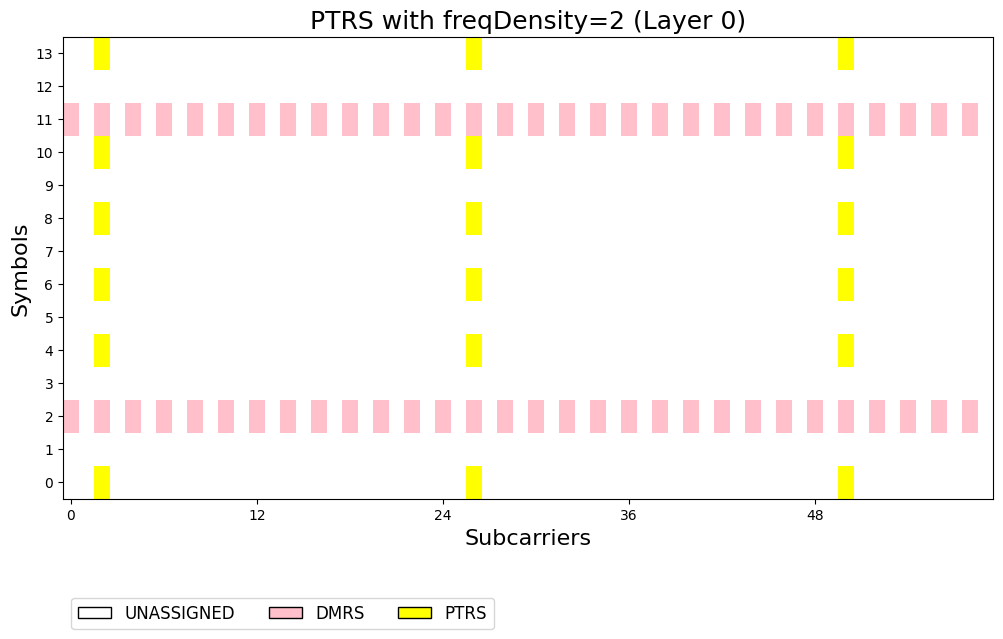
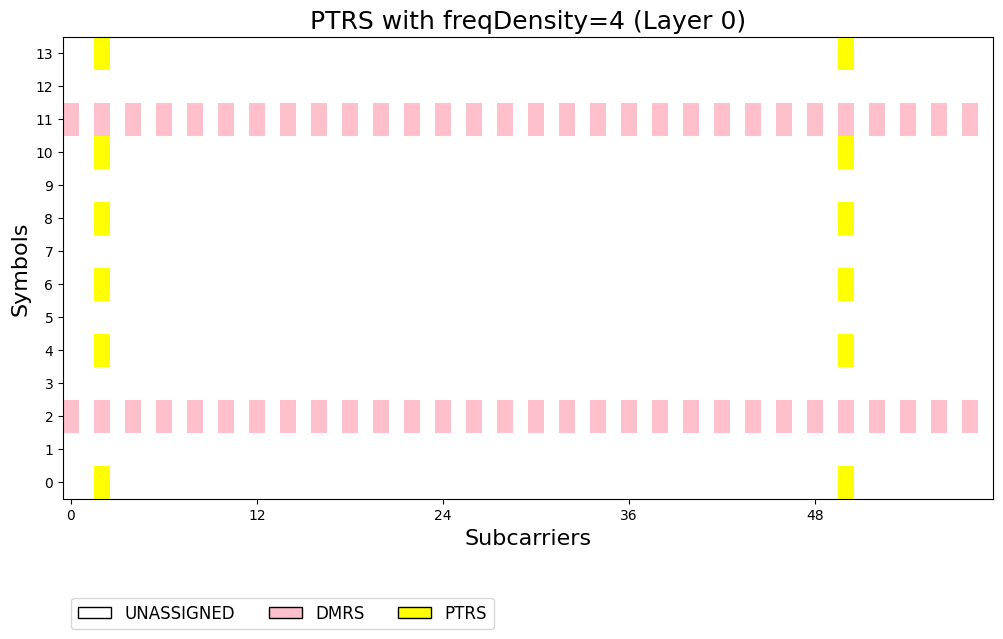
[ ]: